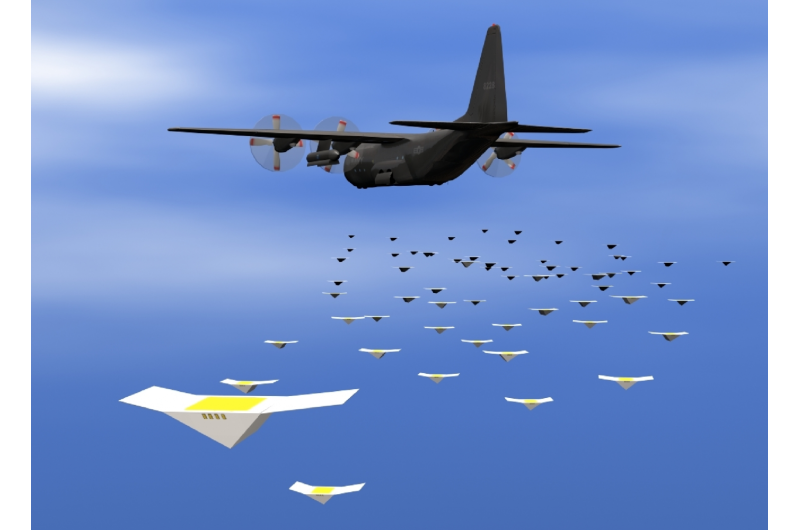July 30, 2017 weblog
Dropping off microdrones, at low cost and easily stacked

The U.S. Naval Research Laboratory has been working on stackable little drones. Payloads could be interconnected to form an ad-hoc, self-configuring network. The Lab has a name for this concept, CICADA which stands for Close-In Covert Autonomous Disposable Aircraft drones.
"Essentially a flying circuit board, CICADA has an extremely high packing factor and a very low per-unit cost," according to the USNRL. The vehicle is inherently stable in glide, with a glide ratio of 3.5. (Glide ratio, said George Leopold in Defense Systems, "is a measure of an unpowered aircraft's forward motion during its descent.")
Back in April, Leopold wrote about the mini-drone under development at the NRL. "The U.S. Navy continues to push the state of the art, scaling individual swarming drones down to a palm-size craft," he said.
CICADA, he added, was part of "an ongoing Pentagon effort to demonstrate and deploy 'advance swarm behaviors' using micro- and mini-drones."
CICADA is a concept for a low-cost, GPS-guided, micro disposable air vehicle that can be deployed in large numbers to "seed" an area with miniature electronic payloads.
Regarding their low cost, Evan Ackerman in IEEE Spectrum, said, "They can carry a small sensor payload, and they're designed to be cheap enough that you can use a whole bunch of them all at once." Another factor weighing in is a 3D-printed fuselage, which minimizes the amount of hands-on assembly time required, he wrote.
"These little guys cost about US $250 each," said Ackerman.
What does that phrase "flying circuit board" mean? IEEE Spectrum: "The CICADA drones themselves consist mostly of a printed circuit board, which makes up the wings and also contains a custom autopilot system that can recover from the crazy tumbling that you can see when the CICADAs are initially deployed."
Ackerman noted that the tiny drones are designed to be carried by other aircraft and dropped, they use GPS and little fins to glide to within 15 feet of their destination."
Ackerman referred to the "MK5" CICADA prototypes.
"With the CICADA MK5, we feel like most of the basic research is done," NRL's Dan Edwards told IEEE Spectrum. "The autopilot works, the guidance works, we've shown different launch methods. Really, we're looking for a customer who wants to commercialize this." A new delivery system, said the report, will launch 32 of them out of a standardized sonobuoy tube all at once.
"The NRL is currently testing a delivery system capable of stacking 32 CICADAs into a single container—think of a tube of Pringles, except stuffed with miniature drones." said Mindy Weisberger in Live Science.
Each CICADA MK5 weighs only 65 grams, and descends at 1,000 feet per minute with a glide ratio of ~3.5, so the higher you launch them from, the farther they'll go, said IEEE Spectrum.
The Lab has been working on its CICADA drones since at least 2011, said Ackerman.
Applications? Edwards in IEEE Spectrum mentioned chemical and biological sensing as interesting ideas. Other electronics could be put in it for seismic sensing along a road, he added.
© 2017 Tech Xplore

















